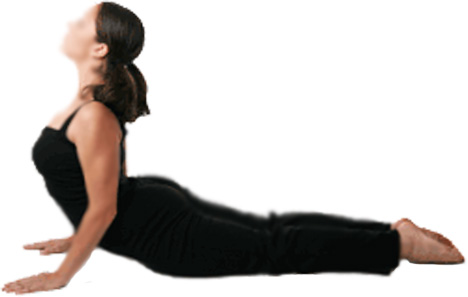
Posture:Naga-asana – The Cobra Pose
Translation:The Sanskrit word naga means snake or serpent. The naga-asana is also known as the bhujanga-asana. The Sanskrit word
bhujanga, which also means snake, is derived from the root bhuj which means to bend or curve.
Pronunciation:na-gah-sa-na
Difficulty:(4)
"Let the body, from navel to toes, touch the ground, the palms placed upon the ground, and raise gently the upper part of the body (from navel to head) like a snake. This posture increases the gastric fire; it destroys all diseases and by constant practice leads to the awakening of Kundalini."
Instructions:
- Lie on the stomach with the head turned to one side and the arms alongside the body with palms facing upward.
- Turn the head and place the chin on the floor. Inhale then exhale slowly through the nostrils and swing the arms around until the hands are placed just below the chin with the palms down and the finger tips of each hand almost touching and the elbows on the floor.
- Inhale slowly through the nostrils, press down on the hands and lift the torso from the waist up off the floor, arching the spine backwards and straightening the arms. Keep the hips on the floor.
- Tilt the head as far back as possible and hold the posture for the duration of the inhaled breath.
- Exhale and reverse the process to return to position.
Comments:
If you find it uncomfortable holding the breath while the posture is held, breath gently through the nostrils. Some may find that they are able to arch the spine back even more than in the initial arch in step 3. In this case try "walking" the hands toward the pelvic region and stretching the head further back.
In addition to the obvious benefits to the spine and lower back, the standard variation of the naga-asana strengthens the wrists and stretches the muscles in the chest. By maintaining a constant exertion to create a greater arch in the spine, the stomach and pelvic muscles are strengthened. Greater strength in these areas can be cultivated by performing the variation where the arms remain on the ground. B.K.S.
Iyengar, a renowned expert in yoga-asanas, claims that displaced spinal discs can be placed back in their original position by practicing the naga-asana.
Duration/Repetitions:
Hold the posture for either the duration of a held inhaled breath or from one-half to three minutes. Repeat the naga-asana two to five times.
Reference:
The Gheranda-samhita


